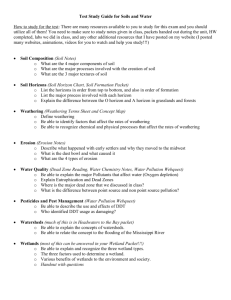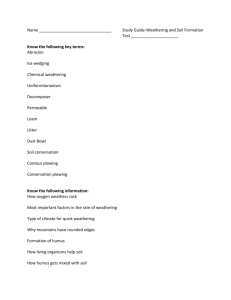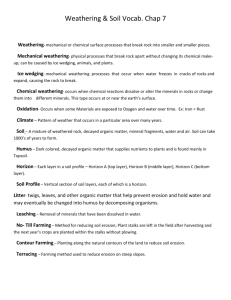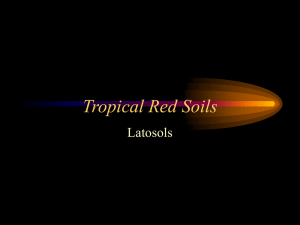7. Weathering and Formation
advertisement
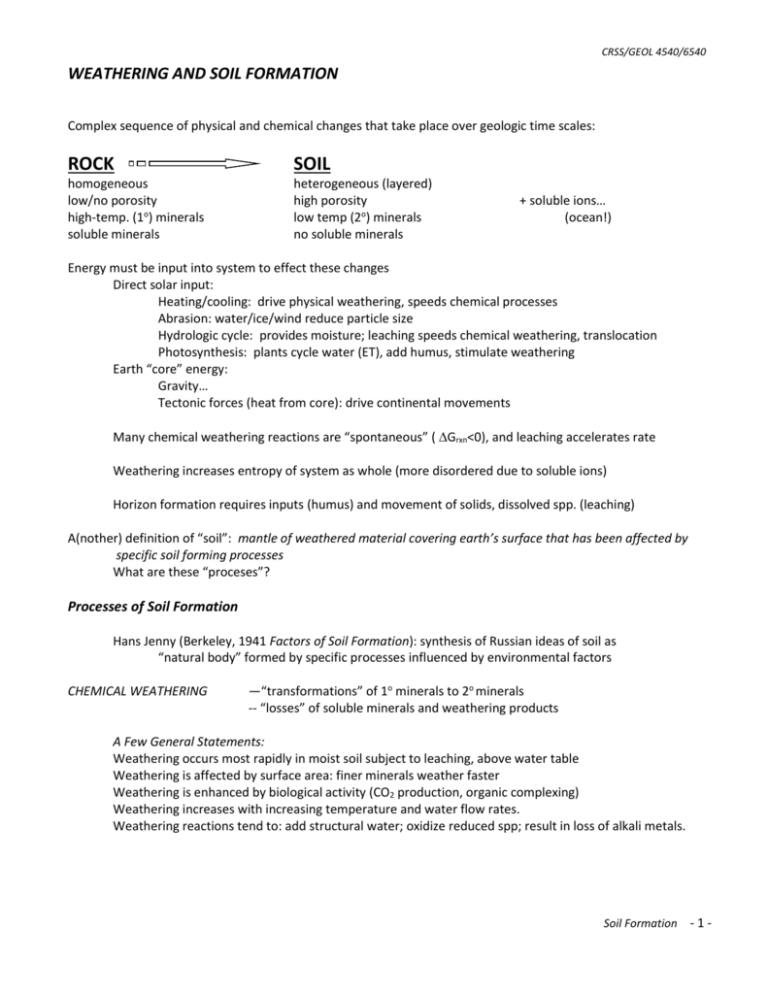
CRSS/GEOL 4540/6540 WEATHERING AND SOIL FORMATION Complex sequence of physical and chemical changes that take place over geologic time scales: ROCK SOIL homogeneous low/no porosity high-temp. (1o) minerals soluble minerals heterogeneous (layered) high porosity low temp (2o) minerals no soluble minerals + soluble ions… (ocean!) Energy must be input into system to effect these changes Direct solar input: Heating/cooling: drive physical weathering, speeds chemical processes Abrasion: water/ice/wind reduce particle size Hydrologic cycle: provides moisture; leaching speeds chemical weathering, translocation Photosynthesis: plants cycle water (ET), add humus, stimulate weathering Earth “core” energy: Gravity… Tectonic forces (heat from core): drive continental movements Many chemical weathering reactions are “spontaneous” ( Grxn<0), and leaching accelerates rate Weathering increases entropy of system as whole (more disordered due to soluble ions) Horizon formation requires inputs (humus) and movement of solids, dissolved spp. (leaching) A(nother) definition of “soil”: mantle of weathered material covering earth’s surface that has been affected by specific soil forming processes What are these “proceses”? Processes of Soil Formation Hans Jenny (Berkeley, 1941 Factors of Soil Formation): synthesis of Russian ideas of soil as “natural body” formed by specific processes influenced by environmental factors CHEMICAL WEATHERING —“transformations” of 1o minerals to 2o minerals -- “losses” of soluble minerals and weathering products A Few General Statements: Weathering occurs most rapidly in moist soil subject to leaching, above water table Weathering is affected by surface area: finer minerals weather faster Weathering is enhanced by biological activity (CO2 production, organic complexing) Weathering increases with increasing temperature and water flow rates. Weathering reactions tend to: add structural water; oxidize reduced spp; result in loss of alkali metals. Soil Formation -1- CRSS/GEOL 4540/6540 Basic Weathering Reactions: 1) Hydrolysis: reaction with H+ CaAl2Si2O8(s)+ H2O + 2H+ ↔ Ca+2 + Al2Si2O5(OH)4(s) (feldspar: 1o) (kaolinite: K = (Ca+2)/(H+)2 2o) : H+ comes from carbonate equilibria (H2O + CO2(g) ↔ H2CO3 ↔ HCO3- + H+) : H+ displaces alkali metals (K, Na, Ca, Mg) from feldspars, micas to form clay minerals : H+ is continually added in rainfall, cations leached out by rainfall : plagioclaise feldspars ((Na,Ca)Si2O8), orthoclaise (KAlSi3O8), muscovite(KAl3Si3O10(OH)2) all weather by similar reactions : product is often kaolinite (1:1 clay mineral), but may be 2:1 (smectite [montmorillonite]) 7NaAlSi2O6 + 6H2O + 6H+ ↔ 3Na0.33Al2.33Si3.67O10(OH)2 + 6 Na+ + 3H4SiO40 (plagioclaise) (montmorillonite) (soluble Si) : over time, Si and Na are leached further, and smectite may transform to kaolinite 6Na0.33Al2.33Si3.67O10(OH)2 + 23H2O + 2H+ ↔ 7Al2Si2O5(OH)4 + 8H4SiO40 + 2Na+ (montmorillonite) (kaolinite) : under intense leaching, soluble Si may be reduced enough to weather kaolinite itself: Al2Si2O5(OH)4 + 2.5H2O ↔ 2Al(OH)3 + H4SiO40 (kaolinite) (gibbsite) MINERAL STABILITY DIAGRAM: -- log(conc): 10-5 M (mol/L) becomes “-5” -- (Na+/H+) shows relative amount of base vs. acid > high pH: low (H+), and high Na+: log(Na+/H+) is BIG (10) > low pH: high H+, prob low Na: log(Na+/H+) is SMALL (2) -- stability fields show what solution composition would favor which mineral -- Early stage weathering: log(Na+/H+) decreases to 8, Si=10-3 in solution: montmorillonite is favored, so analcite dissolves -- Middle stage: log (Na+/H+) decreases to 7 due to Na leaching and acid buildup; Si decreases to 10-3.5: kaolinte forms from dissolving montmorillonite -- Late stage (under some conditions): Si drops so low (<10-4.8) that kaolinite dissolves to fo form gibbsite (Many natural waters and weathering solutions fall in the “kaolinite” stability field; from Langmuir, 1997) Soil Formation -2- CRSS/GEOL 4540/6540 Note: Si SHOULD be held at high levels by presence of amorphous SiO2 and by crystalline quartz; however often the RATE of dissolution of these minerals is slow enough that Si levels in solution drop below their saturation threshold…. NET RESULT: Soils tend to acidify over time and loose basic cations to leaching to groundwater and ultimately the ocean 2) Oxidation/Reduction: mostly oxidation, Fe & Mn Oxidation of Ferrous Iron in Primary Minerals Fe2SiO4 + ½ O2 + 3H2O ↔ 2FeOOH + H4SiO40 (olivine) (goethite) half reactions: 2Fe+2 ↔ 2Fe+3 + 2e½ O2 + 2e- ↔ O-2 : most ferromagnesian minerals weather by oxidation of structural Fe+2 or Mn+2 augite: (Ca,Mg,Fe)SiO3 amphibole (hornblende): Ca2(Mg, Fe, Al)5 (Al, Si)8O22(OH)2 biotite (“black mica”): K(Mg, Fe)3AlSi3O10(F, OH)2 --Fe is in reduced form (Fe+2) in all primary minerals, is unstable in presence of O2 --weathering is usually quite rapid: ferromags disappear from soils pretty quickly --products are Fe oxides and clay minerals (if Al is present) Reduction of Ferric Iron During Pedogenesis --previously oxidized iron (Fe+3) may be reduced during formation of redox depletions and during spodic horizon formation (Bhs) -- this is nearly always coupled with oxidation of organic matter: 6FeOOH + 18H+ + 6e- ↔ 6Fe+2 + 12 H20 (Fe reduction) (goethite) ½ C2H6O +1.5 H2O ↔ CO2 + 6H+ + 6e- (Carbon oxidation) (ethanol) Net rxn: 6FeOOH + ½ C2H6O + 12H+ ↔ 6Fe+2 + CO2(g) + 10.5H20 -- Reduced Fe+2 iron is “mobile” in soil, diffuses away from reduction site to form “depletion” -- Fe+2 can readily be re-oxidized by atmospheric O2 in aerated environment 2Fe+2+ ½ O2 + 2H2O ↔ Fe2O3(s) + 4H+ (hematite) NET RESULT: In aerated soil, all or most of Fe+2 is oxidized to insoluble Fe oxide minerals; under low oxygen conditions where organic C is present, Fe+3 may undergo repeated redox cycles to form redoximorphic features 3) Solution: dissolution of minerals into soluble ions; no solid reaction products halite: gypsum: calcite: quartz: NaCl ↔ Na+ + ClCaSO4·2H2O ↔ Ca+2 + SO4-2 + 2H2O CaCO3 + H2CO3 ↔ Ca+2 + 2HCO3SiO2 + 2H2O ↔ H4SiO40 Soil Formation -3- CRSS/GEOL 4540/6540 -- solution removes soluble minerals from regolith in regions with high rainfall -- in semiarid regions, minerals are pushed down to horizon where they re-precipitate (“Bk”) --quartz and poorly crystalline forms of SiO2 are exceptions: they are only v. slowly soluble and often have low surface areas (i.e., sand grains), thus persist in soils for long time 4) Hydration/Dehydration: gain/loss of structural water from mineral -- many weathering reactions add H2O in form of –O and –OH to weathering products (see hydrolysis examples above) -- a few actual dehydrations: CaSO4·2H2O ↔ CaSO4 + 2H2O (gypsum) (annhydrite) 2FeOOH ↔ Fe2O3 + H2O (goethite) (hematite) [goethite is the yellow mineral, hematite: RED…] 5) Chelation: complexation of soluble ions by soluble organic materials --complexation speeds up weathering reactions by “tying up” soluble reaction products -- polyvalent cations (Ca, Mg, and esp Al and Fe and trace metal cations) are strongly complexed by soluble low-molecular weight organic ligands Ca+2 + 2COOH ↔ 2COOCa + 2 H+ (oxalic acid) --chelated ions are more mobile in soil profile, more subject to leaching/movement > Bhs horizon formation involves chelation of Fe O | C—O-H | C—O-H | O oxalic acid (oxalate) A Note on CATION EXCHANGE: as clays minerals and humus build up during soil formation, cations from weathering reactions can be held on exchange sites and retained in soil. Cation binding to clays and humus is in the order: (Fe, Al) > H > K > (Ca, Mg) > Na As soils become more weathered, H builds up, resulting in release of Al from gibbsite and kaolinite: Al(OH)3 + 3 H+ ↔ Al+3 + 3H2O This Al displaces basic cations from the exchange sites, and the soil become progressively more acid-saturated. Soil Formation -4- CRSS/GEOL 4540/6540 SUMMARY OF CHEMICAL WEATHERING: : feldspars, ferromags, micas: 1o minerals :illite, chlorite: transitional clays formed in initial stage of weathering : in high-base environments, vermiculite and smectites can form : as bases are removed: kaolinite : ultimately: oxides only remain…. Soil Formation -5- CRSS/GEOL 4540/6540 SOIL HORIZON FORMATION Translocation: Primary process of B horizon formation: > clay movement: Bt > humus, Fe movement: Bh, Bhs > carbonates, salts: Bk, etc. Water flow is driving force for movement, but chemical factors must be favorable. Chemical Factors: 1. Clay movement: -- dispersion: chemical forces resulting in repulsion of clay particles : enhanced by low salt content, high pH, low MW organic compounds : clay particles repel each other, move with percolating water -- flocculation: re-aggregation of dispersed clay : high salt, low pH favors flocculation 2. Humus movement: -- low MW organic compounds produced by some vegetation types > pines, other conifers, some tropical vegetation (live oak, myrtle) > tannin-like compounds -- readily leach out of O horizons as dissolved organic matter 3. Fe movement: -- probably a combination of chelation and redox reactions > chelation of Fe by organics leaching from A, O horizons > redox due to high organics in O, A reduces Fe from +3 to +2 -- leached appearance (high chroma, low value) of E is result 4. Salt movement: -- salts dissolve in percolating water -- re-precipitate at depth when wetting front stops (semi-arid climates) Water Flow Considerations Water balance is probably important in movement and re-distribution of all of above P = ET + Q + ΔS P: ET: Q: ΔS: precipitation (50”) evapotranspiration (35”) to atmosphere discharge (15”) thru profile to rivers, ocean soil storage (0) over entire year Over short time periods (monthly), balance between P and ET determines S and how much water is available for Q (leaching, translocation) Soil Formation -6- CRSS/GEOL 4540/6540 Example: humid climate (La.) 20 Water Balance: Louisiana 18 Winter: high P, low ET: -- S is maximum, Q high -- maximum leaching 14 cm H2O Summer: mod. P, high ET --S is low, Q also low -- prob not much leaching 16 12 S 10 P 8 ET 6 Q 4 2 ov ct ec D N O ug Se p A Ju l Ju n pr M ay A M ar Fe b 0 Ja n Most leaching, translocation occurs during months of moisture excess (winter in humid regions) Month (Monthly water balance; assumes S=15 cm, PET=AET) What causes translocation to deposit materials at a given depth? (good question….) 1. Wetting Front: as saturated flow moves downward in dry-ish soil, it stops at some point and suspended/dissolved material is deposited. -- works best for salts in arid/semi-arid climates -- carbonate deposition depth corresponds closely to annual rainfall amount -- salts pushed downward, re-precipitate at depth of wetting front penetration into soil -- doesn’t work so good in humid climates for clay, etc. 2. Water Flow Paths: in profiles with a water-restrictive layer, deposition occurs where water flow is interrupted -- in residual soils (Piedmont), less weathered saprolite may inhibit downward water flow, which is forced laterally (inter-flow) -- may be reasonable on some landscapes, but not on deep, permeable parent materials (Coastal Plain) Soil Formation -7- CRSS/GEOL 4540/6540 3. Water Tables: high seasonal water tables may cause deposition of humus, Fe -- Bh, Bhs horizon depths in Flatwoods often associated with water table depths -- redox gradients at water tables may deposit Fe, then flocculate organics also -- “bath-tub ring” concept: dissolved organics, Fe in groundwater precipitate at surface of water table due to aeration/oxidation -- doesn’t work for clay… 4. Chemical Factors: changes in chemistry in subsoil cause deposition -- re-oxidation, decomposition of organics deposits Fe in WD soils -- for clays: higher salt content, presence of Fe and Al, pH drop cause flocculation > may be a combination of multiple factors > once some clay flocs, subsequent clay may adhere to it May be in a given soil multiple factors operate to cause deposition… An Alternate Theory of Bt Horizon Formation: Australia: “duplex” soils—sandy A, E over clayey Bt; abrupt boundaries with stone lines near base of sandy layers…. no clay films (?); very old landscapes. Bioturbation: disturbance/mixing of surface layers by action of burrowing animals > tropics: ants, termites; humid region: earthworms > primary mechanism by which humus is mixed into A horizon in forests > BUT: if sufficiently deep, and if excavated soil on surface is exposed to rainfall, erosion may selectively erode fines (silt, clay)-leaving sandy surface horizons over residual clayey “B” horizon Depth of animal activity corresponds to depth of combined A, E “B” horizon represents residual clay derived from parent material weathering; evidence of translocation no Duplex-type soils may also result from deposition of sandy over clay in marine environments (Coastal Plain) Soil Formation -8- CRSS/GEOL 4540/6540 Soil Profile Additions Many things may be added to profile during formation, but primary one is: HUMUS The A horizon is defined as: “darkened by humus” (decomposed organic material) : humus is about 50% C: produced by microbial action on plant material Effect of Native Vegetation on Humus Content…. Hardwood Forest: > C “turnover” (annual leaf fall, root turnover) is moderate; much C stored in perennial plant parts (wood); decomposes rapidly > basic cation (Ca, Mg, K) content is moderate; nutrient cations recycled to/ from A horizon -- result: shallow A with moderate basic cation content Coniferous Forest: > C cycling similar to hardwoods, but more resistant to decomposition; O horizon thicker, less humus production > basic cation content is much lower; more acidic -- results: low MW organics leach readily, lead to Bh/Bhs horizon formation : thin, acidic A horizon Prairie Grasses: > large annual biomass turnover: roots, leaves all die over winter (crown only survivies); grasses tend to be fibrous, deep-rooted > basic cation content is high… -- result: high humus content, high-base (alkaline) A horizon Vegetation type is largely determined by climate (rainfall, annual temp./seasonality) Human influence on vegetation (hence, A horizon characteristics) may also be considerable if it occurs over a long enough time period: Prairies maintained by fires (kill invading trees)—managed by American Indians. Plaggen soils of Europe: deep, high-P soils developed over centuries of cultivation. Terra Preta soils of Amazon: middens, charcoal influence (?)—genesis unclear Soil Formation -9- CRSS/GEOL 4540/6540 Soil Formation - 10 -

